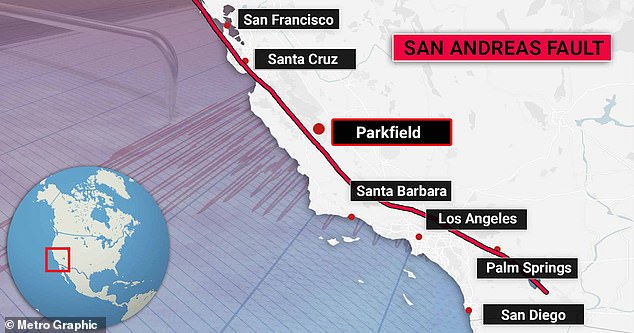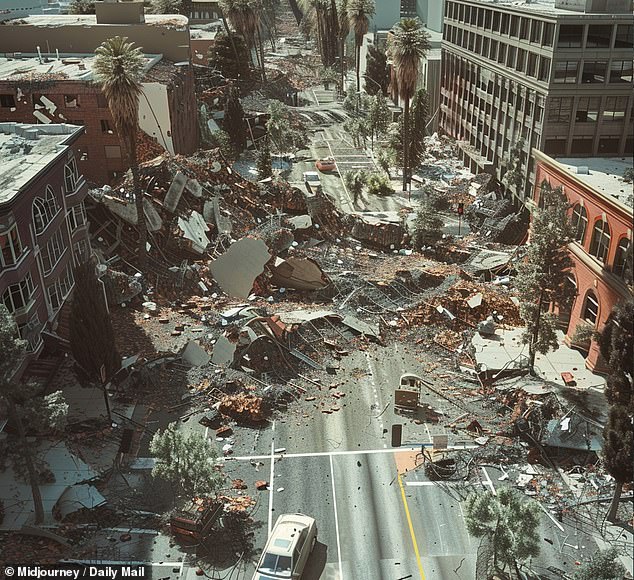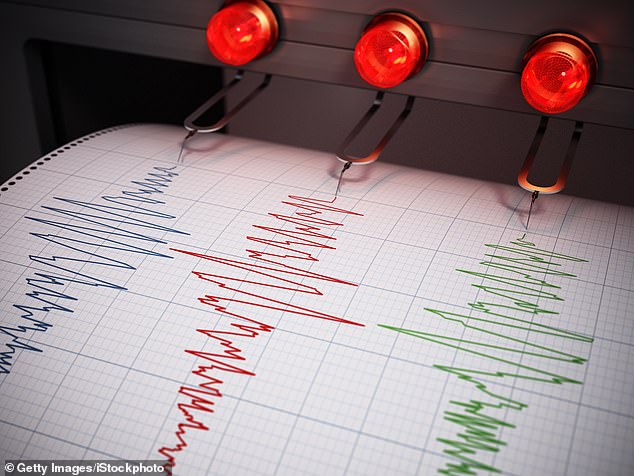California was shaken by three earthquakes in less than 24 hours.
The largest was a magnitude 3.0 earthquake that struck four miles northwest of Walker at 12:33 p.m. local time Wednesday, followed by A magnitude 2.9 earthquake occurred 10 miles northeast of Barstow at 10:45 a.m. local time.
And at 5:40 p.m., the state suffered another blow when a magnitude 2.6 hit two miles east of Pacheco.
Although seismic events are considered minor, Residents in nearby areas, especially near the epicenters, reported feeling the ground shaking. So far, no damage or injuries have been reported.
But this anomaly comes on top of a streak of intense seismic activity that has revived fears of The Big One.
California has been shaken by three earthquakes in 24 hours, which occurred near the towns of Barstow, Walker and Pacheco.
There have been no reports of shaking associated with the magnitude 2.9 earthquake that occurred near Barstow.
But two people, one in Glenbrook, Nevada, and another in Martinez, California, reported feeling weak tremors when the magnitude 3.0 earthquake struck near Walker.
This earthquake occurred along Walker Lane, a 625-mile-long corridor riddled with hundreds of seismic faults that runs along the border between California and Nevada.
Sixteen people reported feeling weak tremors when the magnitude 2.6 earthquake struck near Pacheco.
Everyone who reported shaking was in California, with nine people reporting from Martinez, three from Pleasant Hill, two from Concord, one from Walnut Creek and one from Folsom.
This earthquake occurred along the San Andreas Fault, the volatile boundary between two tectonic plates: the Pacific plate and the North American plate. It runs 800 miles along the California coast.
Tectonic plates are large, solid pieces of the Earth’s crust that move independently of each other.
Both the southern section and the northern section of the San Andreas fault are locked, meaning that friction has caused the North American and Pacific plates to stick together along these parts of their boundary.
When part of a fault becomes blocked in this way, the stress can build up over time and eventually overcome the friction.

A high-magnitude earthquake along the San Andreas River would devastate cities directly on the fault

Researchers have estimated that The Big One would cause approximately 1,800 deaths, 50,000 injuries, and $200 billion in damage.
When all that stored energy is suddenly released, shock waves travel through the Earth’s crust and cause an earthquake.
Both the southern and northern sections of the San Andreas Fault have approximately the same probability of generating a large earthquake in the coming decades.
The San Andreas is widely known for its potential to trigger The Big One: a hypothetical high-magnitude earthquake that will one day occur along this fault.
Researchers have estimated that such an earthquake would cause approximately 1,800 deaths, 50,000 injuries and $200 billion in damage.
Scientists are not able to predict earthquakes, but they have long warned about the inevitability of The Big One.
In fact, California should have done it already. Large earthquakes typically occur every 150 to 200 years, but the San Andreas Fault hasn’t had one in more than three centuries.
California has seen an increase in seismic activity in recent weeks, reigniting fears of The Big One.
Last month, the state broke its record for The largest number of earthquakes of magnitude 4 or greater in a single year.After a magnitude 4.7 earthquake and five aftershocks hit Malibu, marking the 14th earthquake of magnitude 4 or greater to hit Southern California this year.
The average number of earthquakes of magnitude 4 or greater in this region is about eight per year, U.S. Geological Survey (USGS) seismologist Lucy Jones said in a televised question-and-answer session after the quake.
But this intense activity is not a sure sign that The Big One is coming,
Jones said these numbers are “not yet statistically significant,” meaning experts can’t be sure whether the increase is part of a broader trend or just a blip.
Therefore, scientists cannot infer any information about “the largest” of these latest earthquakes. But advances in earthquake forecasting could eventually help us narrow down the timeline for when it might occur.
The three earthquakes that occurred in just 24 hours this week add to the sense that California is experiencing an unusual year for seismic activity.
But like the record number of magnitude 4 earthquakes recorded in the state this year, this anomaly doesn’t mean Californians should prepare for the biggest one.


